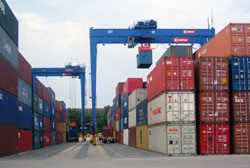 Kalmar's E-One cranes will be used at the Tan Cang-Cai Mep International Container deepwater port |
Saigon Newport Company (SNP) has awarded Cargotec a contract for six all-electric Kalmar E-One rubber-tyred gantry (RTG) cranes, for the first phase of its Tan Cang-Cai Mep International Container deepwater port.
The machines are similar in design to the 20 E-One RTGs that SNP ordered in 2007. The 6+1 wide and 1-over-5 high RTGs are equipped with a container position verification system and will be delivered in the first quarter of 2010. The order value was not disclosed.
Henry Tan, Cargotec's sales director for South East Asia, says SNP selected the RTGs for their "productivity, ease of maintenance, sustainable design and high standard of service".
"The equipment and our service have fulfilled their expectations and our strong relationship with SNP has become even stronger," Tan explains.
He adds that over the years, Cargotec has supplied SNP with RTGs, reach stackers and terminal tractors.
"At the same time, we have strengthened our presence in Vietnam by providing a broader range of equipment, technology and services.
"Vietnam's container industry is developing as trade is growing. We are building on the close co-operation with our customers to play an important role in this development," Tan says.
According to Cargotec, Saigon Newport Company has an annual growth rate of 20% and a 70% share of Ho Chi Minh City's container market. It operates three cargo handling facilities - Tan Cang, Cat Lai and Cai Mep - and two terminals, all situated at the gateway of Ho Chi Minh City.
The Tan Cang-Cai Mep International Container deepwater port project consists of two phases. Phase one that opened on 1 June features a 300-metre (984-foot) long berth that can handle container vessels of 100,000 DWT and a 20-hectare (49-acre) container yard capable of handling 650,000 TEUs a year.
Phase two, which will be completed in November 2010, will see SNP operate the remaining 600 metres (1,988 feet) of berth, capable of handling container vessels of 110,000 DWT, and a 40-hectare (99-acre) container yard that can handle 1.1 million TEUs a year.